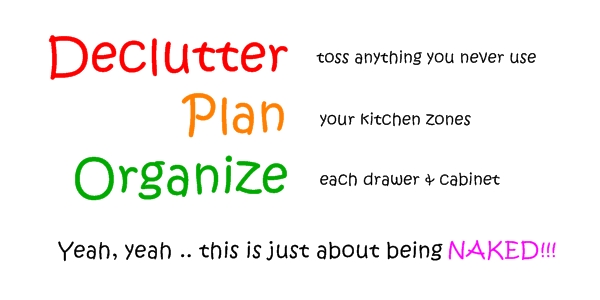We hope you like our little sketch! If so please share it. Thanks.









We hope you like our little sketch! If so please share it. Thanks.









What junk have you got in your prime storage real estate?

Before we get into how to organize a kitchen junk drawer let’s have some fun and think about what this stuff you’re hoarding says about you. It might just help you to let go and TOSS some of it in the trash.
Keys that could be for anything: Means I’m paranoid that I’ll find that door/lock/box that I’ve not needed in 5 years and won’t be able to open it. Not that I knew the key was in the junk drawer in the first place.
Opened packet of throat sweets with a best before date of 5 months earlier. More throat sweets (unopened) dating a year earlier than the other pack. Means I don’t like throat sweets.
Vitamin C tablets: Means I’m forgetful. If they were in the bathroom cabinet I’d forget them, but as they’re in the junk drawer which I visit daily for some reason I won’t forget to take them.
Lottery tickets from a year ago: Means I’m stupid – even if I’d won I’d be too late to claim, so best to not even check.
A comb I bought for my son 5 years ago. Means I have unrealistic expectations of my son. Now 10 he still won’t comb his hair, so we shave most of it off every few weeks to avoid the problem!
So what does your junk drawer say about you?
How about we start with is it OK to have a junk drawer? Doesn’t junk mean it should all be tossed?
Well not necessarily – we all have odds and ends that we need to keep on hand, whether it is rubber bands, twist ties, matches, pens and pencils, labels, batteries, spare keys etc etc.
Our goal should be to have an ORGANIZED junk drawer. If you do, you can free up that time you spend either trying to open or close the drawer or fumbling around in it trying to find what you’re looking for. But how?
Buy, find or make some containers of varying sizes that will fit into your drawer. These establish boundaries for the groups of items you will store in there later so they don’t all get mixed up together again.
Obviously make sure the containers will fit in the drawer – the drawer size is something you must know before you go out shopping for your containers. I love this quote from TheKitchn.com:
“Go ahead and play Tetris with all the containers on the floor of the store to make sure they will fit together inside your drawer.”
Don’t be constrained by containers specifically made for drawers (although this two tiered junk drawer organizer with 22 compartments from Amazon.com, pictured below, is particularly good). You can also consider flatware holders, food storage containers or those for the bathroom. Be creative with your kitchen organization ideas. For free options, think cereal boxes, tea boxes and similar.

TIPS:
Empty the drawer, TOSS any real junk (eg: anything that is broken, pens that no longer work, things you never use) and sort the rest into groups of like items. Do the items really belong in another location? Would beauty products be better off in the bathroom, should batteries and screws really be in the garage or basement?
Avoid keeping paper in your junk drawer. Instead invest in a magnetic sorter box and stick this to the side of your refrigerator. There you can keep takeout menus, coupons and any other papers that you find in the way on your countertops. Organize the holder into sections for each type of paper.
Arrange your bins, boxes or dividers in the drawer and replace your ‘junk’ in an orderly and organized fashion!
Enjoy being able to close the drawer easily.
So how long is all this going to take? Well Stephanie’s Mommy took 15 minutes. Can you manage that?
Of course there is another school of thought that says junk is by its very nature dynamic – so don’t try and organize it, just go through it once a month and TOSS everything that is not essential. What do you think?
Martha Stewart’s raison d’être in the kitchen is to create a functional but beautiful space.
Many of her kitchen organization ideas are fairly well known, such as ensuring you use all of your wall space, group like items and create activity zones, and some are a little over the top. I mean who has a drawer full of skewers and picks and open shelving might be OK for those with perfectly matching dishware sets and attractive pitchers, but for the rest of us, cabinets with doors are a much better idea.


Photo credits: MarthaStewart.com.
However, she also has some great organizing ideas that you might not have heard about elsewhere. So here they are: how to organize a kitchen Martha Stewart style!
Use bird beak shelving for adjustable shelves that can slide in and out. They offer a nice sleek look, with no holes or hardware in sight. Here’s how to make them from an article at LumberJocks.com:

Choose decorative storage options that can be left on display. Pretty bins and baskets can be used to corral items on shelves. Decant your dish liquid into a decorative container to improve the overall look of your kitchen. Display items that you like looking at as long as they don’t become clutter. Make sure they are being functional whilst on display, for example, use attractive platters to store fruit and vegetables.
Use items that you already own as organizers – perhaps a tray as a shelf divider in your glass cabinet or a baking pan to house your spices, oils and vinegars. Hang a pencil and notepad in the pantry and keep an inventory of your items. You’ll have a quick reference point for what you need to use up or stock up on.
Make your own magnetic message board that matches the colors of your kitchen and use it to keep track of family life. Click HERE to learn how.
Install under cabinet lighting to ensure your countertops are not hidden in the shadows and brighten up every inch of your kitchen.
Don’t underestimate the uses of a rolling cart. They offer storage wherever needed, an extra workspace whenever needed and could even be used as a sideboard or bar when entertaining. They are particularly useful in tight kitchens.
Ensure your family’s safety is paramount by not overlooking this often forgotten element of kitchen organization. Keep a fire extinguisher and first aid kit close by.
For more Martha Stewart kitchen and organizing ideas and tips, check out the Martha Stewart Living Magazine.


Does organizing your home feel like climbing a mountain?
Is it filled with cute and functional organizing tools; bins, baskets, tubs, dividers, labeled file folders? You name it, you’ve got it and they are all filled with the appropriate items.
Do you have a calendar on the wall and another in your purse to keep track of your (and everyone else’s) appointments and schedule?
But do you still have a problem?
I bet you can’t get into a rhythm of looking at said calendars except when you remember to write things on them (which isn’t always) and even though you started out with the best of intentions, you find yourself letting things pile up on the kitchen counter and your desk, even though they really do have a home (bin, basket, tub, divider or file folder) waiting to welcome them in. You want to be organized. But….
Being organized isn’t something you do. It’s actually more of who you are.
You don’t ‘do’ politeness or hospitality, you are polite and hospitable.
So while the key to organizing your house does include having bins, baskets, tubs and all the rest, having those things doesn’t make you stay organized. YOU make you stay organized. But, how, you ask?
The ability to stay motivated to perform a task is often directly related to successfully achieving a similar task before. So use this to your advantage by breaking your overall organizing goals down into bite sized tasks and ticking them off as you go. Each one you tick off will motivate you to start another.
Be practical when considering how long it will take you to get organized. Once you take the leap into being organized, initial successes may spur you on, but if you are expecting overnight success, your enthusiasm may soon wane. Stay organized by recognizing that this is a lifestyle change, not a one-off event.
Recognize your successes as you proceed and reward yourself for what you achieve. Tie in your reward to the size of the task or to the amount of your overall goal you have completed – this could be a short break, a coffee, your favorite dessert, a trip to the cinema or even a short vacation.

Organizing every day will help you stay motivated by making the task habitual. Even if you can only spare 2 minutes a day, make sure you use them. As you will probably not be looking forward to these 2 minutes, it is best to get them over with first thing in the morning. This way you are more likely to stick to the routine.
Keep being organized easy by having your tools of the trade ready to go and on hand at all times. By ‘tools of the trade’ I mean your Keep, Donate/Sell and Trash bins. Keep them in your garage, basement or mudroom and take them with you to wherever you are organizing.
Surround yourself with ‘being organized’ auras to immerse yourself in this lifestyle change. Subscribe to ‘How to get organized‘ magazines or online resources (shameless plug!) so you will constantly be reminded about organization and can be inspired by others. Get excited about your plans and successes and talk about them publicly with friends and on places like Facebook.
Take into account that sometimes you will not be able to perform your daily organizing tasks – you may be sick, there may be an emergency or any number of other things could get in the way. The key is to not let that demotivate you and to restart your program asap. The longer you leave it, the harder it is to get started again. If you have had more than a few days off, pick one goal and start really, really small. You’ll soon be back on track.

 How To Get Motivated To Organize Your Home In 9 Easy Steps
How To Get Motivated To Organize Your Home In 9 Easy Steps
Motivation is a huge part of learning to get organized. Follow our simple 9 step plan and find out how to get motivated to organize your home today.
 Save $000s By Getting Organized
Save $000s By Getting Organized
Save nearly $2000 in your kitchen alone just by getting organized. Sounds too good to be true? Check out our facts and figures.
 How To Get Organized: 6 Roadblocks To Getting Started
How To Get Organized: 6 Roadblocks To Getting Started
You can learn all about how to get organized but none of it will work if you don’t overcome the roadblocks stopping you from getting started.
Photo credits: mckaysavage, theogeo and vtdainfo.
With the economy in the state that it is, saving money is high on everyone’s agenda.

If you are also one of the 25% of Americans who would like to be better organized, then here’s a great reason to get started:
Being organized saves you money.
Not just a few $$$ either – it could be thousands.
Here’s how:
If you are feeling out of control with your job and housing situation, rising costs and other life uncertainties, empower yourself by getting organized at home and at least being in charge of what you own.
Find out what you have got hidden away. Work room by room, going from cabinet to closet to outdoor shed and remind yourself of what it is you have cluttering up your home.
Then next time you go shopping you will know you don’t need another bottle of soy sauce or that pair of red shoes that are such a bargain.
As well as spending money on duplicates when you don’t know what you have lurking in the back of those kitchen cabinets, the kitchen is a key place where you can save money by being organized.
Keep a magnetized dry erase board on your refrigerator or freezer telling you exactly what you have stored in there. Do the same for food cabinets, keeping the board on the inside of the cupboard door.
Reach for leftovers first and preserve anything you can’t eat right away. Freeze food in one meal portion sizes.
By knowing what you have, you won’t buy duplicates and you won’t let things go to waste.
A recent study by the Food and Agriculture Organization of the United Nations (FAO) found that North American consumers wasted an average of 20% of the food they buy, which equates to a saving of $750 per year.

Details: Food waste varies across categories from 4% for oilseeds and pulses to 33% for fish and seafood. The average is 20%. Based on an average annual expenditure on food detailed in the 2009 Consumer Expenditure Survey of $3753, 20% equals $750.
Sources: FAO and 2009 Consumer Expenditure Survey
By being organized with your weekly or monthly menus, you can save time and stress as well as money. You won’t need to search through your fridge or cabinets for something to cook and you won’t need to give up and order in a takeaway. You will also save money by cutting out unnecessary trips to the grocery store where you will more than likely buy more than you went for.
So make your own magnetic menu planning board, reclaim your kitchen and start cooking again. Just cutting your takeaway or restaurant spend by a quarter, will save you $655 per year.
Details: 25% of the average annual expenditure on food away from the home of $2619 equals $655.
Sources: 2009 Consumer Expenditure Survey and Kimboscrafts Blogspot for how to make a magnetic menu planning board.

Do you just ignore those discount attracting rectangles in your Sunday newspaper? They’re not worth much after all. Or are they? The Promotion Marketing Association’s (PMA) Coupon Council says different. In fact a typical family spending 10 minutes or less per week on couponing can save up to $500 per year using coupons, but these figures are from 2008. Since then coupon use has leapt 27%. The Wall Street Journal even considers coupon users shrewder than they first appear, showing how using coupons equates to a salary of $100 per hour. Of course, your coupons will need to be organized and their redemption planned so click here for A Beginner’s Guide to Couponing.
Sources: PMA Press Release and The Wall Street Journal article
The key to being organized is to declutter first. When going through those closets, drawers, cabinets, boxes etc, you will be amazed at what you may find – things you thought you’d lost and even things you didn’t know you had. I recently found $160 in an old wallet tucked at the back of my junk drawer – that was a nice surprise!
As well as possibly finding cash and gift cards tucked away, you will come across items that you no longer need or want, perhaps clothes you didn’t really like when you got them home, old toys your kids have grown out of, DVDs you’ve watched and won’t watch again. Turn those items into cash. Your key decluttering piles on our ‘How to organize your home‘ journey of “Keep, Donate and Trash” can instead be turned into “Keep, Sell and Trash”.
Try selling your items via online auction sites such as Ebay or online classified ads such as Craigslist. Alternatively consider any consignment shops in your area, who will display your goods and give you a percentage of the sales price for anything they sell. To learn how a consignment shop works, please click here.
Alternatively you could have a yard or garage sale. Statistics from YardSaleSearch.com suggest that on average, sellers make $400 by getting rid of their unwanted items this way.

If you don’t have the time or can’t be bothered to sell any of your no longer needed but good condition items, at least donate them to charity rather than throw them in the bin. This can still save you some money in the way of tax deductions. To be eligible you must tally up the market values of what you are donating, keep itemized records and keep any receipts received from the charity. For more specific information please click here.

Once you have decluttered your home, the chances are that you will have a number of storage bins, boxes and binders that are now empty. Rather than buying new organizing products for your ‘Keep’ pile, you can re-use these empty containers. Also instead of investing in new storage solutions, consider alternative uses for existing household items. Food jars are ideal for holding utensils, pencils, screws etc or for making candle holders for the garden. Empty shoe boxes are great for keeping shoes (!) from getting cluttered in your closet or for use as drawer dividers, perhaps for socks.
If you are disorganized with your finances, the chances are you will miss a payment due date and incur late fees. On credit cards alone this mounts up to $116 per year on average per credit cardholder. And this does not even include the interest accruing on overdue balances or other forms of credit such as overdrafts. So get your bills organized, forecast your bank balances to ensure any shortfalls are managed and do not miss any payment dates.

If you are in control of your finances, you will know what you spend. Just analyzing this in detail once a month will help you prioritize your spending, offering you potential savings that were just a black hole before.
Late fees also apply in a smaller way to rented movies or library books, so diarizing due dates in advance can save you money here too.
Details: Based on $20.5bn penalty fees in 2009 shared between 176.8m credit cardholders.
Source: Credit Card Industry Facts from CreditCards.com
With gas prices sky rocketing, being organized with your errands can save you money on fuel. Plan out your week’s trips so you can schedule locations that are close to each other to be visited on the same day. If you’re doing any grocery shopping, pack a cooler with ice to keep your food fresh. And remember don’t go shopping without a list – you’ll only end up needing another visit to the store later in the week.

According to GasBuddy.com, “In many areas, gas prices can vary by 20-30 cents per gallon or more within a very small area.” So be organized and check out their site before you fill up to find the cheapest gas station in your neighborhood. You could save about $200 per year just by shopping around.
Details: 30 cents per gallon saved equates to roughly 10%. This saving on a total annual spend on gas and motor oil of $1986 equates to $199.
Source: 2009 Consumer Expenditure Survey
Diairise the routine maintenance of your car and home to avoid large expenditures.
Save on utility bills by being organized with your laundry – make sure you always fill the tub for maximum efficiency.
Try and steer clear of impulsive shopping trips – plan what you need to buy and when you need to buy it. Impulse purchases should then be curtailed.
Shop around online to get the best deals for significant and even every day purchases. Keep your eye out for coupons and special offers that mean you can shop early for upcoming birthday or Christmas presents.
Being organized generally reduces stress levels. And given that “The Centers for Disease Control and Prevention state unequivocally that 80% of our medical expenditures are now stress related.”, it would appear that being organized can help reduce medical expenses and time taken off work sick.

Quote: FastCompany.com
If you encourage friends and family to become more organized, you could all help each other as part of a frugal community. Ideas include coupon sharing and buying together in bulk. For all 10 Ways to Save Money by Organizing a Frugal Community, please click the link.
You may also be able to save money indirectly by selling your house faster if it is on the market by having an organized home to show off to potential buyers.
As you can see learning how to get organized can save you a lot of money. Just remember it’s not all about buying organizing products and doing nothing with them. It’s about a lifestyle change from pack rat to declutterer and generally thinking about living your life in a more organized way.
 How To Get Motivated To Organize Your Home In 9 Easy Steps
How To Get Motivated To Organize Your Home In 9 Easy Steps
Motivation is a huge part of learning to get organized. Follow our simple 9 step plan and find out how to get motivated to organize your home today.
 How To Get Organized: 6 Roadblocks To Getting Started
How To Get Organized: 6 Roadblocks To Getting Started
You can learn all about how to get organized but none of it will work if you don’t overcome the roadblocks stopping you from getting started.
 How To Get Organized: 5 Common Pitfalls To Avoid
How To Get Organized: 5 Common Pitfalls To Avoid
There are 5 common pitfalls that stand between you and getting organized. If you can overcome them, you can learn how to get organized more easily.
Photo credits:
SeniorLiving.org, goosmurf, krossbow, daniel spils, alancleaver_2000, Evil Erin, MoneyBlogNewz, jo-h and exfordy.